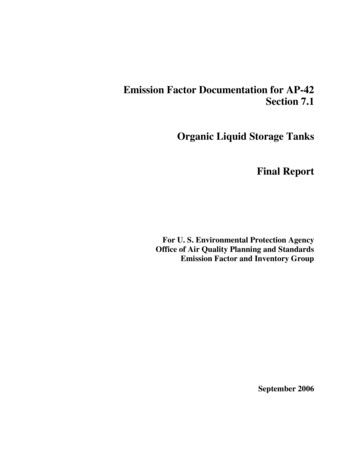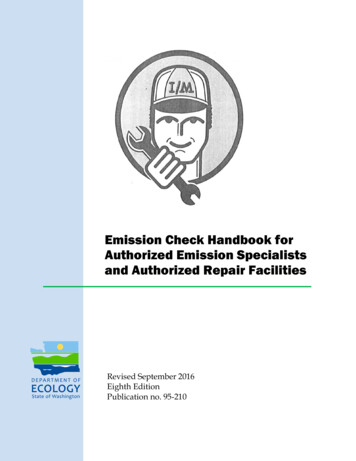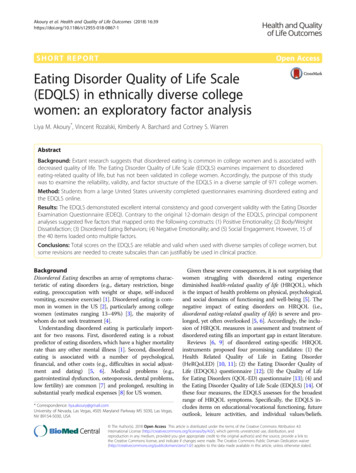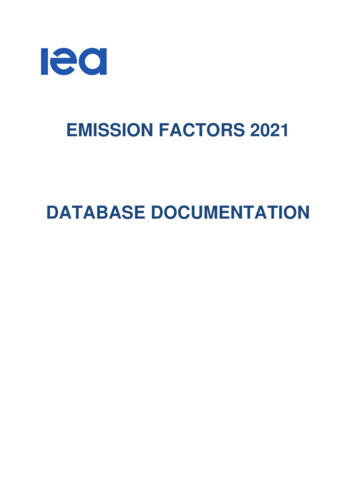
Transcription
Emission Factor Documentation for AP-42Section 7.1Organic Liquid Storage TanksFinal ReportFor U. S. Environmental Protection AgencyOffice of Air Quality Planning and StandardsEmission Factor and Inventory GroupSeptember 2006
Emission Factor Documentation for AP-42Section 7.1Organic Liquid Storage TanksFinal ReportFor U. S. Environmental Protection AgencyOffice of Air Quality Planning and StandardsEmission Factor and Inventory GroupResearch Triangle Park, NC 27711Attn: Mr. Michael CiolekSeptember 2006
TABLE OF CONTENTSPage1.0 INTRODUCTION .1-12.0 STORAGE TANK DESCRIPTIONS .2.1 INTRODUCTION .2.2 TYPES OF STORAGE TANKS .2.2.1Fixed-Roof Tanks .2.2.2External Floating Roof Tanks.2.2.3Internal Floating Roof Tanks.2.2.4Domed External Floating Roof Tanks .2.2.5Horizontal Tanks .2.2.6Pressure Tanks .2.2.7Variable Vapor Space Tanks .2.3 TYPES OF FLOATING ROOF PERIMETER SEALS .2.3.1External and Domed External Floating Roof Seals .2.3.2Internal Floating Roof Seals .2.4 TYPES OF FLOATING ROOF DECK FITTINGS .2.4.1External and Domed External Floating Roof Fittings .2.4.2Internal Floating Roof Fittings .2.5 REFERENCES -263.0 EMISSION ESTIMATION PROCEDURES .3.1 INTRODUCTION .3.1.1Total Losses From Fixed Roof Tanks.3.1.2Total Losses From Floating Roof Tanks .3.1.3Variable Vapor Space Tanks .3.1.4Pressure Tanks .3.2 HAZARDOUS AIR POLLUTANTS (HAPs) SPECIATION METHODOLOGY .3.3 REFERENCES .3-13-13-13-143-293-303-313-784.0 EMISSION ESTIMATION PROCEDURES FOR FIXED ROOF TANKS .4.1 BREATHING LOSS EQUATIONS.4.2 COMPARISON OF PREDICTIVE ABILITY OF TWO EQUATIONS .4.2.1Predictive Ability--Actual Data .4.2.2Predictive Ability--Default Values .4.3 SENSITIVITY ANALYSIS .4.4 CONCLUSIONS AND RECOMMENDATIONS .4.5 REFERENCES .4-14-14-34-44-54-64-94-305. EMISSION ESTIMATION PROCEDURES FOR FLOATING ROOF TANKS.5.1 STATISTICAL ANALYSES - API TANK TEST DATA .5.1.1Evaluation of Rim Seal Loss Factors.5.1.2Evaluation of Wind Speed Calculation.5.1.3Evaluation of Diameter Function and Product Factor .5.1.4Deck Fitting Loss Factors.5-15-15-25-245-255-27iii
TABLE OF CONTENTS (continued)Page5.25.35.45.55.1.5Development of the Fitting Wind Speed Correction Factor .5.1.6Deck Seam Factors .5.1.7Vapor Pressure Functions .PREDICTIVE ABILITY - ACTUAL TANK TEST DATA .5.2.1Standing Storage Loss .5.2.2Internal Floating Roof Emissions .SENSITIVITY ANALYSES .5.3.1Standing Storage Loss .5.3.2Withdrawal Loss.CONCLUSIONS .REFERENCES .6. SUMMARY OF CHANGES TO AP-42 SECTION .6.1 CHANGES TO EMISSION ESTIMATION PROCEDURES AND FACTORS FOR FIXEDROOF TANKS.6.2 CHANGES TO EMISSION ESTIMATION PROCEDURES AND FACTORS FORFLOATING ROOF TANKS 6-16-1
LIST OF FIGURESPageFigure 2-1.Figure 2-2.Figure 2-3.Figure 2-4.Figure 2-5.Figure 2-6.Figure 2-7.Figure 2-8.Figure 2-9.Figure 2-10.Figure 2-11.Figure 2-12.Figure 2-13.Figure 2-14.Figure 2-15.Figure 3-1a.Figure 3-2a.Figure 3-1b.Figure 3-2b.Figure 3-3.Figure 3-4.Figure 3-5.Figure 3-6.Figure 3-7.Figure 3-8.Figure 3-9.Figure 3-10.Figure 3-11.Figure 4-1.Figure 4-2.Figure 4-3.Figure 4-4.Figure 4-5.Typical fixed roof tank.External floating roof tank (pontoon type) .External floating roof tank (double-deck type).Internal floating roof tank .Domed external floating roof tank .Typical underground storage tank.A typical above-ground horizontal tank.Vapor mounted primary seals .Liquid-mounted and mechanical shoe primary seals .Secondary rim seals.Deck fittings for floating roof tanks.Deck fittings for floating roof tanks.Slotted and unslotted guidepoles.Ladder and well.Bottom conditions for landing loss .True vapor pressure of crude oils with a Reid vapor pressure of 2 to15 pounds per square inch.True vapor pressure of refined petroleum stocks with a Reid vapor pressureof 1 to 20 pounds per square inch .Equation for true vapor pressure of crude oils with a Reid vapor pressure of2 to 15 pounds per square inch.Equation for true vapor pressure of refined petroleum stocks with a Reidvapor pressure of 1 to 20 pounds per square inch .Vapor pressure function coefficient (A) of refined petroleum stocks with aReid vapor pressure of 1 to 20 psi, extrapolated to 0.1 psi .Vapor pressure function coefficient (B) of refined petroleum stocks with aReid vapor pressure of 1 to 20 psi, extrapolated to 0.1 psi .Equations to determine vapor pressure constants A and B for refinedpetroleum stocks .Vapor pressure function coefficient (A) of crude oil stocks with aReid vapor pressure of 2 to 15 psi, extrapolated to 0.1 psi .Vapor pressure function coefficient (B) of crude oil stocks with aReid vapor pressure of 2 to 15 psi, extrapolated to 0.1 psi .Equations to determine vapor pressure Constants A and B for crude oilsstocks.Equations for the daily maximum and minimum liquid surface temperatures.Turnover factor (KN) for fixed roof tanks .Vapor pressure function .Sensitivity of Equation 4-1 to changes in molecular weight (MV).Sensitivity of Equation 4-2 to changes in molecular weight (MV).Sensitivity of Equation 4-1 to changes in vapor pressure (PV) .Sensitivity of Equation 4-2 to changes in vapor pressure (PV) .Sensitivity of Equation 4-1 to changes in the vapor space outage -233-243-243-253-264-104-114-124-134-14
LIST OF FIGURES (continued)PageFigure 4-6.Figure 4-7.Figure 4-8.Figure 4-9.Figure 4-10.Figure 4-11.Figure 5-1.Figure 5-2.Figure 5-3.Figure 5-4.Figure 5-5.Figure 5-6.Figure 5-7.Figure 5-8.Figure 5-9.Figure 5-10.Sensitivity of Equation 4-2 to changes in the vapor space outage (HVO).Sensitivity of Equation 4-1 to changes in the average ambient temperaturerange (ªT).Sensitivity of Equation 4-2 to changes in the average ambient temperaturerange (ªT).Sensitivity of Equation 4-1 to changes in the paint factor values (FP).Sensitivity of Equation 4-2 to changes in the solar absorptance (%).Sensitivity of Equation 4-2 to changes in the daily solar insolationfactors (I).Emissions after a rim-mounted secondary seal as a function of primary sealtype.Efficiency of rim-mounted secondary seal as a function of primary seal type .Emissions after a rim-mounted secondary seal as a function of primaryseal gap size .Efficiency of a rim-mounted secondary seal as a function of primary sealgap size.Effect of secondary gap on efficiency: Case 1--vapor mounted primary with1 inch gap .Effect of secondary gap on efficiency: Case 2--shoe mounted primary with9.4 inch gap .Effect of secondary gap on efficiency: Case 3--shoe mounted primary with39.2 inch gap .Effect of secondary gap on emissions: Case 4--shoe mounted primary with1 inch gap .Effect of secondary gap on emissions: Case 5--shoe mounted primary with13.2 inch gap .Calculated losses as a function of diameter 55-165-175-185-195-205-23
LIST OF TABLESPageTABLE 3-1.LIST OF ABBREVIATIONS USED IN THE TANK EQUATIONS .3-44TABLE 3-2.PROPERTIES (MV, WVC, PV) OF SELECTED PETROLEUM LIQUIDS.3-46TABLE 3-3.PHYSICAL PROPERTIES OF SELECTED PETROCHEMICALS.3-47TABLE 3-4.ASTM DISTILLATION SLOPE FOR SELECTED REFINEDPETROLEUM STOCKS .3-49VAPOR PRESSURE EQUATION CONSTANTS FOR ORGANICLIQUIDS .3-50TABLE 3-6.PAINT SOLAR ABSORPTANCE FOR FIXED ROOF TANKS.3-52TABLE 3-7.METEOROLOGICAL DATA (TAX, TAN, I) FOR SELECTED U.S.LOCATIONS.3-53RIM-SEAL LOSS FACTORS, KRa, KRb and n, FOR FLOATING ROOFTANKS .3-59AVERAGE ANNUAL WIND SPEED (v) FOR FOR SELECTED U.S.LOCATIONS.3-60TABLE 3-10. AVERAGE CLINGAGE FACTORS, C.3-64TABLE 3-11. TYPICAL NUMBER OF COLUMNS AS A FUNCTION OF TANKDIAMETER FOR INTERNAL FLOATING ROOF TANKS WITHCOLUMN-SUPPORTED FIXED ROOFS.3-64TABLE 3-12. DECK-FITTING LOSS FACTORS, KFa, KFb, AND m, AND TYPICALNUMBER OF DECK FITTINGS, NF .3-65TABLE 3-13. EXTERNAL FLOATING ROOF TANKS: TYPICAL NUMBER OFVACUUM BREAKERS, Nvb, AND ROOF DRAINS, Nd .3-67TABLE 3-14. EXTERNAL FLOATING ROOF TANKS: TYPICAL NUMBER OFDECK LEGS, NL .3-68TABLE 3-15. INTERNAL FLOATING ROOF TANKS: TYPICAL NUMBER OF DECKLEGS, Nl, AND STUB DRAINS, Nd .3-69TABLE 3-16. DECK SEAM LENGTH FACTORS (SD) FOR TYPICAL DECKCONSTRUCTIONS FOR INTERNAL FLOATING ROOF TANKS .3-69TABLE 3-5.TABLE 3-8.TABLE 3-9.vii
LIST OF TABLES (continued)TABLE 3-17. ROOF LANDING LOSSES FOR INTERNAL FLOATING ROOF TANKWITH A LIQUID HEEL .3-70TABLE 3-18. ROOF LANDING LOSSES FOR EXTERNAL FLOATING ROOF TANKWITH A LIQUID HEEL .3-71TABLE 3-19. ROOF LANDING LOSSES FOR ALL DRAIN-DRY TANKS .3-72TABLE 3-20. HENRY'S LAW CONSTANTS FOR SELECTED ORGANIC LIQUIDS(REFERENCE 15) .3-74TABLE 3-21. CORRECTION OF HENRY'S LAW FACTOR FOR A TEMPERATUREDIFFERENT FROM STANDARD .3-77TABLE 4-1.FIXED ROOF TANK BREATHING LOSS--COMPARISON OFESTIMATING EQUATIONS--API DATA BASE .4-21FIXED ROOF TANK BREATHING LOSS -- COMPARISON OFESTIMATING EQUATIONS--WOGA DATA BASE .4-21FIXED ROOF TANK BREATHING LOSS--COMPARISON OFESTIMATING EQUATIONS--EPA DATA BASE .4-22COMPARISON OF EMISSION ESTIMATING EQUATIONS WITHBREATHING LOSS AS A FUNCTION OF STOCK TYPE.4-23COMPARISON OF EMISSION ESTIMATING EQUATIONS WITHBREATHING LOSS AS A FUNCTION OF VAPOR PRESSURE .4-24FIXED ROOF TANK BREATHING LOSS -- COMPARISON OFESTIMATING EQUATIONS -- WOGA DATA BASE DEFAULTVALUES.4-24FIXED ROOF TANK BREATHING LOSS--COMPARISONOF ESTIMATING EQUATIONS--EPA DATA BASE DEFAULTVALUES.4-25TABLE 4-8.SUMMARY OF STATISTICAL ANALYSIS VALUES .4-26TABLE 4-9.COMPARISON OF BREATHING LOSS ESTIMATING EQUATIONS(USING DEFAULT VALUES)--PREDICTIVE ABILITY AS AFUNCTION OF PRODUCT TYPE.4-27TABLE 4-2.TABLE 4-3.TABLE 4-4.TABLE 4-5.TABLE 4-6.TABLE 4-7.viii
LIST OF TABLES (continued)TABLE 4-10. BREATHING LOSS ESTIMATING EQUATIONS FIXED ROOF TANKSSENSITIVITY ANALYSIS--COMPARISON BETWEEN THE AP-42 ANDNEW API EQUATION BASELINE CONDITIONS.4-28TABLE 4-11. BREATHING LOSS ESTIMATING EQUATIONS FIXED ROOF TANKSSENSITIVITY ANALYSIS .4-29TABLE 5-1.BASIS OF RIM-SEAL LOSS FACTORS.5-4TABLE 5-2.SUMMARY OF RIM SEAL LOSS FACTORS, KRa, KRb, AND n .5-6TABLE 5-3.COMPARISON OF ESTIMATING EQUATION COEFFICIENTS:INDIVIDUAL CASES .5-8COMPARISON OF ESTIMATING EQUATIONS FOR AVERAGEFITTING SEAL LOSS FACTORS .5-11COMPARISON OF SLOTTED GUIDE POLE PARAMETERESTIMATES .5-31SUMMARY OF RESULTS FOR LINEAR MODEL ANALYSES OF ALLFITTINGS.5-34RECOMMENDED GROUPING OF SLOTTED GUIDE POLE FITTINGSAND PARAMETERS FOR AP-42 .5-36COMPARISON OF UNSLOTTED GUIDE POLE PARAMETERESTIMATES .5-38SUMMARY OF PARAMETER ESTIMATES - CB&I/API REPLICATEANALYSES.5-40TABLE 5-10. SUMMARY OF PARAMETER ESTIMATES - MRI ANALYSES .5-41TABLE 5-11. RECOMMENDED DECK-FITTING LOSS FACTORS, KFa, KFb,AND m.5-46TABLE 5-12. NONCONTACT DECK SEAM LOSS FACTORS BY TEST .5-53TABLE 5-13. CONTACT DECK SEAM LOSS FACTORS BY TEST .5-53TABLE 5-14. TANK PARAMETERS RECORDED DURING TESTS BY THEWESTERN OIL AND GAS ASSOCIATION.5-57TABLE 5-4.TABLE 5-5.TABLE 5-6.TABLE 5-7.TABLE 5-8.TABLE 5-9.ix
LIST OF TABLES (continued)TABLE 5-15. PREDICTED AND ACTUAL EMISSION FROM TANKS TESTEDBY THE WESTERN OIL AND GAS ASSOCIATION.5-58TABLE 5-16. RELATIVE ERRORS CALCULATED FOR PREDICTED EMISSIONSPRESENTED IN TABLE 5-13 .5-58TABLE 5-17. FIELD TEST TANK PARAMETERS .5-60TABLE 5-18. RESULTS OF SENSITIVITY ANALYSIS FOR THE STANDINGSTORAGE LOSS EQUATION FOR EXTERNAL FLOATING ROOFTANKS .5-62TABLE 5-19. RESULTS OF SENSITIVITY ANALYSIS FOR THE STANDINGSTORAGE LOSS EQUATION FOR INTERNAL FLOATINGROOF TANKS.5-66TABLE 5-20. SENSITIVITY ANALYSIS OF WITHDRAWAL LOSSES FROMEXTERNAL FLOATING ROOF TANKS .5-69TABLE 5-21. SENSITIVITY ANALYSIS OF WITHDRAWAL LOSSES FROMINTERNAL FLOATING ROOF TANKS.5-71x
EMISSION FACTOR DOCUMENTATION FOR AP-42 SECTIONOrganic Liquid Storage Tanks1.0 INTRODUCTIONThe document Compilation of Air Pollutant Emission Factors (AP-42) has been published by theU. S. Environmental Protection Agency (EPA) since 1972. Supplements to AP-42 have been routinelypublished to add new emission source categories and to update existing emission factors. AP-42 isroutinely updated by EPA to respond to new emission factor needs of EPA, State and local air pollutioncontrol programs, and industry.An emission factor is a representative value that attempts to relate the quantity of a pollutantreleased to the atmosphere with an activity associated with the release of that pollutant. The emissionfactors presented in AP-42 may be appropriate to use in a number of situations, such as making sourcespecific emission estimates for areawide inventories for dispersion modeling, developing controlstrategies, screening sources for compliance purposes, establishing operating permit fees, and makingpermit applicability determinations. The purpose of this report is to provide background information tosupport revisions to AP-42 Section 7.1, Organic Liquid Storage Tanks.This background report consists of six chapters. Chapter 1 includes the introduction to the report.Chapter 2 gives basic descriptions of fixed roof tanks, floating roof tanks, variable vapor space tanks, andhorizontal tanks. It also includes descriptions of the different types of rim seals and deck fittings onfloating roof tanks. Chapter 3 presents the emission estimation procedures for each tank type, as well asthe methodology for hazardous air pollutant (HAP) speciation. Chapter 4 provides an evaluation of theequations that predict standing storage and working losses from fixed roof tanks. Chapter 5 provides anevaluation of the equations that predict standing storage and withdrawal losses from floating roof tanks.Chapter 6 is a summary of changes to the section since the previous edition of AP-42 (February 1996).1-1
2.0 STORAGE TANK DESCRIPTIONS2.1. INTRODUCTIONThis chapter presents basic descriptions of fixed-roof tanks (vertical and horizontal);internal, external, and domed external floating roof tanks; pressure tanks; and variable vaporspace tanks. In addition, the chapter provides descriptions of perimeter seals and fittings forinternal, external, and domed external floating roofs.2.2. TYPES OF STORAGE TANKSSeven types of vessels are used to store volatile organic liquids (VOL):1.2.3.4.5.6.7.Fixed-roof tanks;External floating roof tanks;Internal floating roof tanks;Domed external floating roof tanks;Horizontal tanks;Pressure tanks; andVariable vapor space tanks.The first four tank types are cylindrical in shape with the axis oriented perpendicular to thefoundation. These tanks are almost exclusively above ground. Horizontal tanks (i.e., with theaxis parallel to the foundation) can be used above ground and below ground. Pressure tanks oftenare horizontally oriented and "bullet" or spherically shaped to maintain structural integrity at highpressures. They are located above ground. Variable vapor space tanks can be cylindrical orspherical in shape. The discussion below contains a detailed description of each of these tanktypes.2.2.1. Fixed-Roof TanksOf currently used tank designs, the fixed-roof tank is the least expensive to construct andis generally considered the minimum acceptable equipment for storing VOL's. A typicalfixed-roof tank, which is shown in Figure 2-1, consists of a cylindrical steel shell with a cone- ordome-shaped roof that is permanently affixed to the tank shell. Most recently built tanks are ofall-welded construction and are designed to be both liquid- and vapor-tight. However, older tanksmay be of riveted or bolted construction and may not be vapor-tight. A breather valve(pressure-vacuum valve), which is commonly installed on many fixed-roof tanks, allows the tankto operate at a slight internal pressure or vacuum. Breather vents are typically set at 0.19 kPa(0.75 in. w.c.) on atmospheric pressure fixed-roof tanks.1 Because this valve prevents the releaseof vapors during only very small changes in temperature, barometric pressure, or liquid level, theemissions from a fixed-roof tank can be appreciable. Additionally, gauge hatches/sample wells,float gauges, and roof manholes provide accessibility to these tanks and also serve as potentialsources of volatile emissions. Breather vents may be called conservation vents, although hardlyany conservation of vapors occurs at such low pressure settings. Generally, the term conservationvent is used to describe a pressure setting of 17 kPa (67 in. w.c.) or less. Vents with settingsgreater than 17 kPa (67 in. w.c.) are commonly called pressure' vents.2-1
2.2.2 External Floating Roof Tanks2A typical external floating roof tank consists of an open-topped cylindrical steel shellequipped with a roof that floats on the surface of the stored liquid, rising and falling with theliquid level. The floating roof is comprised of a deck, fittings, and rim seal system. Floating roofdecks are constructed of welded steel plates and are of three general types: pan, pontoon, anddouble deck. Although numerous pan-type decks are currently in use, the present trend is towardpontoon and double-deck type type floating roofs. The two most common types of externalfloating-roof tanks are shown in Figures 2-2 and 2-3. Manufacturers supply various versions ofthese basic types of floating decks, which are tailored to emphasize particular features, such asfull liquid contact, load-carrying capacity, roof stability, or pontoon arrangement. The liquidsurface is covered by the floating deck, except in the small annular space between the deck andthe shell; the deck may contact the liquid or float directly above the surface on pontoons.External floating roof tanks are equipped with a rim seal system, which is attached to the roofperimeter and contacts the tank wall. The rim seal system slides against the tank wall as the roofis raised and lowered. The floating deck is also equipped with fittings that penetrate the deck andserve operational functions. The external floating roof design is such that evaporative losses fromthe stored liquid are limited to losses from the rim seal system and deck fittings (standing storageloss) and any exposed liquid on the tank walls (withdrawal loss).2.2.3 Internal Floating Roof Tanks3An internal floating roof tank has both a permanent fixed roof and a floating roof inside.There are two basic types of internal floating roof tanks: tanks in which the fixed roof issupported by vertical columns within the tank; and tanks with a self-supporting fixed roof and nointernal support columns. The fixed roof is not necessarily free of openings but does span theentire open plan area of the vessel. Fixed roof tanks that have been retrofitted to employ aninternal floating roof are typically of the first type, while external floating roof tanks that havebeen converted to an internal floating roof tank typically have a self-supporting roof. Tanksinitially constructed with both a fixed roof and an internal floating roof may be of either type. Aninternal floating roof tank has both a permanently affixed roof and a roof that floats inside thetank on the liquid surface (con
Emission Factor and Inventory Group September 2006 . Emission Factor Documentation for AP-42 Section 7.1 Organic Liquid Storage Tanks Final Report . Equations for the daily maximum and minimum liquid surface temperatures. 3-24 Figure 3-10. Turnover factor (K










